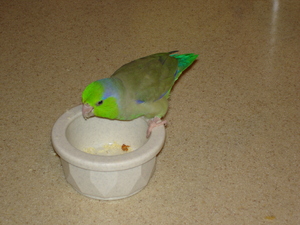Birds prefer their feathers in order. It’s simply a fact. They’ll preen themselves silly, setting all their feathers in proper alignment, transferring oil from their oil grand onto their feathers. It is true that this ritual is what makes them water-resistant, so that in nature, come rainstorms or high water, they do not get drenched to the bone. However, in a household, and when you’re cuddling your little parrotlet, it can get quite smelly.
Parrotlets are not like other birds when it comes to bathing. They are simply too small and too fragile to stick under a kitchen faucet or under a shower head. Their tiny bodies cannot withstand the high amounts of water pressure, and beyond that, they won’t sit still for it. The best way to keep your parrotlet smelling fresh then, is to offer him a small bathtub in the form of a clear dish. Opaque, shiny, or brightly colored dishes tend to frighten them, so your best bet would be a shallow translucent plastic bowl. My parrotlet’s bathtub is a clear plastic candy dish in the shape of a shell, and he love it dearly. It is not necessary to fill it with a great deal of water, 6 centimeters will do, after all, they are pocket-sized creatures. The water should not be cold nor hot, room temperature or slightly cooler is best.
For the most part, parrotlets do not like to be given baths. Unlike cockatiels, which enjoy being misted by a spray bottle, parrotlets have minds of their own and like to give themselves baths of their own accord. It is important not to force your parrotlet, especially at a young age, into bathing. Often times, it will frighten the bird. Instead, place the dish on top of or near his cage with some favorite toys close by. This encourages the parrotlet to approach the water on his own, and most parrotlets come to love giving themselves baths by sticking their heads in the water and flinging water drops all over themselves. Other times, it is best to demonstrate the use of the water for your new parrotlet, by dipping your fingers in the water to show your bird that the clear substance is actually present, and then flinging a few water drops on the bird gently. This introduces him to the concept of wet, and with time, most parrotlets consider it great fun to get wet. And having their “flock”, that is, you, there for baths can provide an opportunity for bonding and gives the baby parrotlet security in unknown waters, no pun intended.
Be sure, however, to make sure that after your bird is done bathing, he is put in a warm place so that he can dry. Birds, especially smaller ones like parrotlets, can catch colds. And, if their immune system is worn out, they can catch human colds and sicknesses as well, another reason to keep your bird’s diet balanced and healthy and his immune system up. Parrotlets especially enjoy sunning themselves, and this provides warmth for them to dry off and also the necessary vitamins that come from the sun, such as vitamin E which also helps maintain the coat luster. If worst comes to worst, most parrotlets do not object to being wrapped in a towel or blow-dried on cool temperature and low power, making sure that the blow dryer is constantly in motion so that it does not overheat a patch of skin and inadvertently burn your parrotlet.



